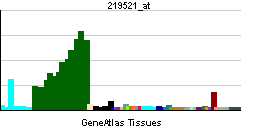B3GAT1
| Beta-1,3-glucuronyltransferase 1 (glucuronosyltransferase P) | |||||||||||||
|---|---|---|---|---|---|---|---|---|---|---|---|---|---|
 PDB rendering based on 1v82. | |||||||||||||
| |||||||||||||
| Identifiers | |||||||||||||
| Symbols | B3GAT1 ; CD57; GLCATP; GlcAT-P; GlcUAT-P; HNK-1; LEU7; NK-1 | ||||||||||||
| External IDs | Template:OMIM5 Template:MGI HomoloGene: 49551 | ||||||||||||
| |||||||||||||
| RNA expression pattern | |||||||||||||
 | |||||||||||||
| More reference expression data | |||||||||||||
| Orthologs | |||||||||||||
| Template:GNF Ortholog box | |||||||||||||
| Species | Human | Mouse | |||||||||||
| Entrez | n/a | n/a | |||||||||||
| Ensembl | n/a | n/a | |||||||||||
| UniProt | n/a | n/a | |||||||||||
| RefSeq (mRNA) | n/a | n/a | |||||||||||
| RefSeq (protein) | n/a | n/a | |||||||||||
| Location (UCSC) | n/a | n/a | |||||||||||
| PubMed search | n/a | n/a | |||||||||||
Beta-1,3-glucuronyltransferase 1 (glucuronosyltransferase P), also known as B3GAT1 or CD57, is a human gene.[1]
The protein encoded by this gene is a member of the glucuronyltransferase gene family. These enzymes exhibit strict acceptor specificity, recognizing nonreducing terminal sugars and their anomeric linkages. This gene product functions as the key enzyme in a glucuronyl transfer reaction during the biosynthesis of the carbohydrate epitope HNK-1 (human natural killer-1, also known as CD57 and LEU7). Alternate transcriptional splice variants have been characterized.[1]
In immunology, the CD57 antigen (CD stands for cluster of differentiation) is a protein which is also called HNK1 (human natural killer-1) or LEU7. It is a neuronally expressed adhesion molecule with a carbohydrate epitope that contains a sulfoglucuronyl residue.[2]
References
- ↑ 1.0 1.1 "Entrez Gene: B3GAT1 beta-1,3-glucuronyltransferase 1 (glucuronosyltransferase P)".
- ↑ Mitsumoto Y, Oka S, Sakuma H, Inazawa J, Kawasaki T (2000). "Cloning and chromosomal mapping of human glucuronyltransferase involved in biosynthesis of the HNK-1 carbohydrate epitope". Genomics. 65 (2): 166–73. doi:10.1006/geno.2000.6152. PMID 10783264.
Further reading
- Andersson B, Wentland MA, Ricafrente JY; et al. (1996). "A "double adaptor" method for improved shotgun library construction". Anal. Biochem. 236 (1): 107–13. doi:10.1006/abio.1996.0138. PMID 8619474.
- Yu W, Andersson B, Worley KC; et al. (1997). "Large-scale concatenation cDNA sequencing". Genome Res. 7 (4): 353–8. PMID 9110174.
- Tone Y, Kitagawa H, Imiya K; et al. (1999). "Characterization of recombinant human glucuronyltransferase I involved in the biosynthesis of the glycosaminoglycan-protein linkage region of proteoglycans". FEBS Lett. 459 (3): 415–20. PMID 10526176.
- Mitsumoto Y, Oka S, Sakuma H; et al. (2000). "Cloning and chromosomal mapping of human glucuronyltransferase involved in biosynthesis of the HNK-1 carbohydrate epitope". Genomics. 65 (2): 166–73. doi:10.1006/geno.2000.6152. PMID 10783264.
- Pedersen LC, Tsuchida K, Kitagawa H; et al. (2000). "Heparan/chondroitin sulfate biosynthesis. Structure and mechanism of human glucuronyltransferase I.". J. Biol. Chem. 275 (44): 34580–5. doi:10.1074/jbc.M007399200. PMID 10946001.
- Cebo C, Durier V, Lagant P; et al. (2002). "Function and molecular modeling of the interaction between human interleukin 6 and its HNK-1 oligosaccharide ligands". J. Biol. Chem. 277 (14): 12246–52. doi:10.1074/jbc.M106816200. PMID 11788581.
- Ouzzine M, Gulberti S, Levoin N; et al. (2002). "The donor substrate specificity of the human beta 1,3-glucuronosyltransferase I toward UDP-glucuronic acid is determined by two crucial histidine and arginine residues". J. Biol. Chem. 277 (28): 25439–45. doi:10.1074/jbc.M201912200. PMID 11986319.
- Brenchley JM, Karandikar NJ, Betts MR; et al. (2003). "Expression of CD57 defines replicative senescence and antigen-induced apoptotic death of CD8+ T cells". Blood. 101 (7): 2711–20. doi:10.1182/blood-2002-07-2103. PMID 12433688.
- Strausberg RL, Feingold EA, Grouse LH; et al. (2003). "Generation and initial analysis of more than 15,000 full-length human and mouse cDNA sequences". Proc. Natl. Acad. Sci. U.S.A. 99 (26): 16899–903. doi:10.1073/pnas.242603899. PMID 12477932.
- Jirásek T, Hozák P, Mandys V (2003). "Different patterns of chromogranin A and Leu-7 (CD57) expression in gastrointestinal carcinoids: immunohistochemical and confocal laser scanning microscopy study". Neoplasma. 50 (1): 1–7. PMID 12687271.
- Jeffries AR, Mungall AJ, Dawson E; et al. (2004). "beta-1,3-Glucuronyltransferase-1 gene implicated as a candidate for a schizophrenia-like psychosis through molecular analysis of a balanced translocation". Mol. Psychiatry. 8 (7): 654–63. doi:10.1038/sj.mp.4001382. PMID 12874601.
- Chochi K, Ichikura T, Majima T; et al. (2004). "The increase of CD57+ T cells in the peripheral blood and their impaired immune functions in patients with advanced gastric cancer". Oncol. Rep. 10 (5): 1443–8. PMID 12883721.
- Kakuda S, Shiba T, Ishiguro M; et al. (2004). "Structural basis for acceptor substrate recognition of a human glucuronyltransferase, GlcAT-P, an enzyme critical in the biosynthesis of the carbohydrate epitope HNK-1". J. Biol. Chem. 279 (21): 22693–703. doi:10.1074/jbc.M400622200. PMID 14993226.
- Matsubara K, Yura K, Hirata T; et al. (2005). "Acute lymphoblastic leukemia with coexpression of CD56 and CD57: case report". Pediatric hematology and oncology. 21 (7): 677–82. PMID 15626024.
- Ibegbu CC, Xu YX, Harris W; et al. (2005). "Expression of killer cell lectin-like receptor G1 on antigen-specific human CD8+ T lymphocytes during active, latent, and resolved infection and its relation with CD57". J. Immunol. 174 (10): 6088–94. PMID 15879103.
- Assouti M, Vynios DH, Anagnostides ST; et al. (2006). "Collagen type IX and HNK-1 epitope in tears of patients with pseudoexfoliation syndrome". Biochim. Biophys. Acta. 1762 (1): 54–8. doi:10.1016/j.bbadis.2005.09.005. PMID 16257185.
- Barré L, Venkatesan N, Magdalou J; et al. (2006). "Evidence of calcium-dependent pathway in the regulation of human beta1,3-glucuronosyltransferase-1 (GlcAT-I) gene expression: a key enzyme in proteoglycan synthesis". FASEB J. 20 (10): 1692–4. doi:10.1096/fj.05-5073fje. PMID 16807373.
- Sada-Ovalle I, Torre-Bouscoulet L, Valdez-Vázquez R; et al. (2007). "Characterization of a cytotoxic CD57+ T cell subset from patients with pulmonary tuberculosis". Clin. Immunol. 121 (3): 314–23. doi:10.1016/j.clim.2006.08.011. PMID 17035093.
External links
- CD57+Antigen at the US National Library of Medicine Medical Subject Headings (MeSH)
| Stub icon | This membrane protein–related article is a stub. You can help Wikipedia by expanding it. |